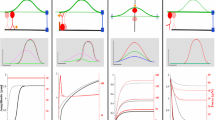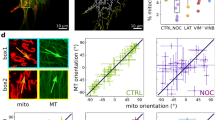Summary
The antarctic teleost, Pagothenia borchgrevinki inhabits the Antarctic Ocean where the water temperature remains around -1.9° C throughout the year. Dermal melanophores of this fish respond within minutes to epinephrine and theophylline with melanosome aggregation and dispersion, respectively. Numerous cytoplasmic microtubules are present in these cells despite the low environmental temperature. In longitudinal profiles, many microtubules are twisted, beaded and sometimes even branched. In cross sections, C-, U-, S-, 6- and other irregularly shaped tubules are observed. Nocodazole partially disrupts microtubules and inhibits epinephrine-induced pigment aggregation. Pigment movements are also prevented by erythro-9-[3-(2-hydroxynonyl)] adenine. Although the participation of these incomplete microtubules in cell motility remains uncertain, the results indicate that this fish has a cold-resistant microtubule system on which melanosome movements depend. Unlike those in melanophores, microtubules in the axons of spinal nerves are of uniform thickness and often contain an electron-dense core in the center.
Similar content being viewed by others
References
Beckerle MC, Porter KR (1983) Analysis of the role of microtubules and actin in erythrophore intracellular motility. J Cell Biol 96:354–362
Behnke O (1967) Incomplete microtubules observed in mammalian blood platelets during microtubule polymerization. J Cell Biol 34:697–701
Brady ST, Tytell M, Lasek RJ (1984) Axonal tubulin and axonal microtubules: Biochemical evidence for cold stability. J Cell Biol 99:1716–1724
Clark TG, Rosenbaum JL (1982) Pigment particle translocation in detergent-permeabilized melanophores of Fundulus heteroclitus. Proc Natl Acad Sci USA 79:4655–4659
DeVries AL (1976) Antifreezes in cold-water fishes. Oceanus 19:23–31
Dustin P (1984) Microtubules (2nd edition), Springer, Berlin
Golz R, Hauser M (1985) Polymorphic assemblies of tubulin in the reticulopodial network (RPN) of Allogromia. Eur J Cell Biol 36 (Suppl 7):21
Littlepage JL (1965) Oceanography, investigations in McMurdo Sound, Antarctica. Biol Antarctic Seas II, Antarct Res Ser 5:1–37
Meyer-Rochow VB (1985) A study of unusual intracellular organelles and ultrastructural organisation of the eye of Gammarus oceanicus Segerstråle 1947 fixed in the midnight sun of the Spitsbergen (Svalbard) summer. Biomed Res 6:353–365
Meyer-Rochow VB, Klyne MA (1982) Retinal organization of the eyes of three nototheniid fishes from the Ross Sea (Antarctica). Gegenbaurs Morphol Jahrb 128:762–777
Meyer-Rochow VB, Pyle Ca (1980) Fatty acid analysis of lens and retina of two Antarctic fishes and of the head and body of the Antarctic amphipod Orchomene plebs. Comp Biochem Physiol 65B:395–398
Murphy DB, Tilney LG (1974) The role of microtubules in the movement of pigment granules in teleost melanophores. J Cell Biol 61:757–779
Obika M (1986) Intracellular transport of pigment granules in fish chromatophores. Zool Sci 3:1–11
Obika M, Negishi S (1985) Effects of hexylene glycol and nocodazole on microtubules and melanosome translocation in melanophores of the medaka Oryzias latipes. J Exp Zool 235:55–63
Obika M, Turner WA, Negishi S, Menter DG, Tchen TT, Taylor JD (1978) The effects of lumicolchicine, colchicine and vinblastine on pigment migration in fish chromatopores. J Exp Zool 205:95–109
Schliwa M, Euteneuer U (1978) A microtubule-independent component may be involved in granule transport in pigment cells. Nature 273:556–558
Schliwa M, Euteneuer U (1983) Comparative ultrastructure and physiology of chromatophores, with emphasis on changes associated with intracellular transport. Am Zool 23:479–494
Williams RG, Correia JJ, DeVries AL (1985) Formation of microtubules at low temperature by tubulin from antarctic fish. Biochemistry 24:2790–2798
Author information
Authors and Affiliations
Rights and permissions
About this article
Cite this article
Obika, M., Meyer-Rochow, V.B. Ultrastructure of microtubules in dermal melanophores and spinal nerve of the Antarctic teleost Pagothenia borchgrevinki . Cell Tissue Res. 244, 339–343 (1986). https://doi.org/10.1007/BF00219209
Accepted:
Issue Date:
DOI: https://doi.org/10.1007/BF00219209




